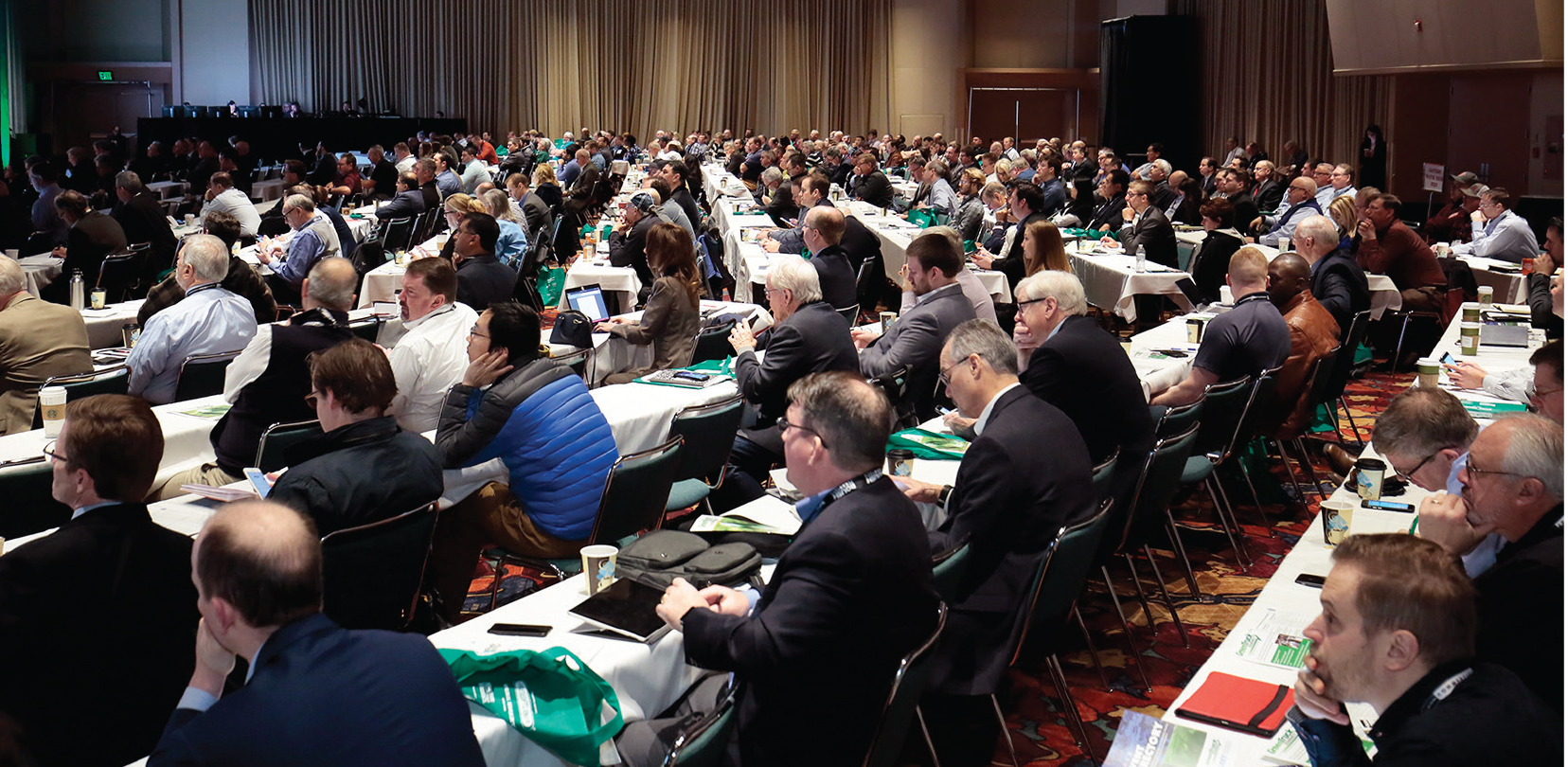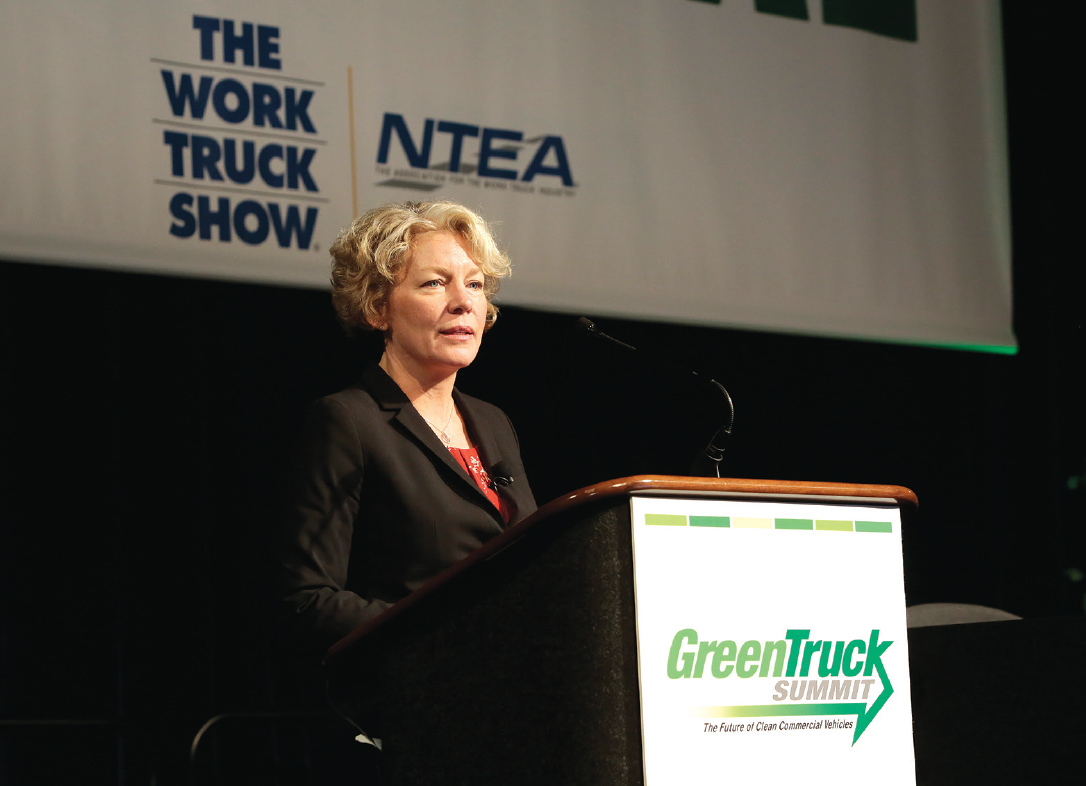This article was published in the April 2018 edition of NTEA News.
Hundreds of industry professionals gathered at the 2018 Green Truck Summit to learn how
the industry can immediately influence greenhouse gas and criteria pollutant reduction. Held March 6–8 in conjunction with The Work Truck Show® 2018 and Fleet Technical Congress, the Summit featured expert insights, with presentations from regulatory agencies, fleet managers, commercial vehicle manufacturers, and stakeholders from industry trade associations and professional societies. Sponsored by Freightliner Trucks, this year’s event featured a keynote address and six general sessions on opening day. For the remainder, attendees could choose from 48 concurrent sessions.

Keynote address
Kary Schaefer, general manager of marketing and strategy at Daimler Trucks North America, gave this year’s keynote address. Her speech highlighted the diversity of available new technologies and ongoing developments in clean diesel, natural gas and electrification. Schaefer highlighted the benefits of green-related innovation, including more uptime, efficiencies and an enhanced bottom line. In her presentation, she covered active safety systems, connectivity and propulsion technologies.
Schaefer cited a study validating that safety system installation dramatically reduces accidents. She emphasized the business case for safety as lowering incidents allows for more uptime. “Today, we’ve evolved and iterated,” said Schaefer. Looking ahead, collision mitigation systems will feature full braking for pedestrians; camera functionality enabling recognition of traffic/speed signs, displays, and more; lane departure warning systems; and side guard assist (detects objects in the blind spot and warns drivers of a highway lane change).
Connectivity involves vehicle data. Having a high level of detail provides significant opportunities to increase operational efficiency and understand when maintenance needs arise. According to Schaefer, it’s important to take the information collected and turn it into actionable steps for fleets. She indicated factors can be combined to create predictive models that, in the future, anticipate issues before they happen.
Schaefer presented propulsion as an alternative to diesel. Right now, there’s considerable buzz in the industry about battery electric vehicles. Today, Daimler is delivering real, production-level electric trucks, making significant investment in battery technology. Schaefer outlined some hurdles to electric vehicle deployment, such as range (i.e., travel distance per change), weight (energy density per pack), cost and charging (overall time required). Electricity costs vary greatly across the U.S. depending on the source; rates change almost hourly. In short, some setups lend themselves to electric compatibility better than others.
During her keynote, Schaefer shared, “Natural gas has come a long way.” It’s now commercially proven and readily available, with advantages for noise abatement. She acknowledged Daimler sees natural gas as an important consideration for fleet operation. The biggest challenge is cost, causing many to avoid natural gas investment.
She made the point that “Diesel is our workhorse. Diesel is here to stay.” From her vantage point, innovation in diesel technology will continue to be critical to ensure a green, sustainable future.
To Schaefer, “Green means much more than just tailpipe emissions. Green means running an efficient business.” She referenced the greenhouse gas Phase Two target of 25-percent reduction in fuel consumption by 2027. Considering the many different fuel options, Schaefer concluded: “Bottom line, there’s not one silver bullet for these different fuel technologies.” There’s not a one-size-fits-all solution. It’s important to weigh the pros and cons of what’s available and select the right fit for your fleet. She encouraged attendees to ask questions, explore new technology, compare options and find out how to best lower cost of ownership.

Kary Schaefer gives the Green Truck Summit keynote address.
General session overview
Six general sessions followed the keynote address. The first explained how government, industry and end users plan to generate greater fuel efficiencies. Attendees learned how current regulations and offerings (and their ability to be deployed) will shape work truck purchases and productivity in the next decade and beyond.
In the following session, leading fleet visionaries from PepsiCo, NGVAmerica and UPS Corporate Automotive discussed existing and near-term emerging technology and fuel usage information and what that means for work trucks and buses. Current and pending real-world opportunities were part of the conversation, with specifics on workplace hybrids, renewable diesel and CNG, lightweighting, connected trucks, near-zero-emission ICE, and electric traction (including fuel cells).
The next session featured a panel moderated by John Davis — creator, host and executive producer of MotorWeek (and Green Truck Summit emcee for the fourth consecutive year). In this forum, attendees were reminded of the fact work trucks have become increasingly complex and sophisticated, reflecting consumer demand, new technologies, connectivity, electrification and alternative fuels. Leaders from Ford, Cummins, Odyne and Workhorse shared their viewpoints on how consumer demand for business performance and the advancement of powertrain and vehicle technologies are influencing productivity and efficiency in the work truck industry.
Strategies for obtaining advanced technology approval and selecting alternative fuels were detailed in the subsequent presentation. Attendees heard a forward-thinking approach to selecting and justifying use of technologies and fuels. Experts shared the value of simultaneously presenting both capital and operations budgets for advanced technology in work trucks. Fleet representatives explained how balancing initial, infrastructure and operational costs influences the long term and covered why this is critical to successful buy-in for today’s purchase approval.
The next session delivered a roadmap to available local, state and federal funds. Experts explored how and why funding is important — but not a forever strategy to fleet transformation. Attendees gained awareness of viable options and how to access them. Presenters provided details on VW settlement activity and how organizations are using these funds.
The final Green Truck Summit general session, presented by Mark Thompson (principal of Decision Processes International), revealed insights gained from successes and challenges shared by many attendees and others through interviews and surveys. This presentation emphasized that having a targeted, winning strategy is critical when developing an organizational approach toward implementing or marketing alternative technologies and fuels.